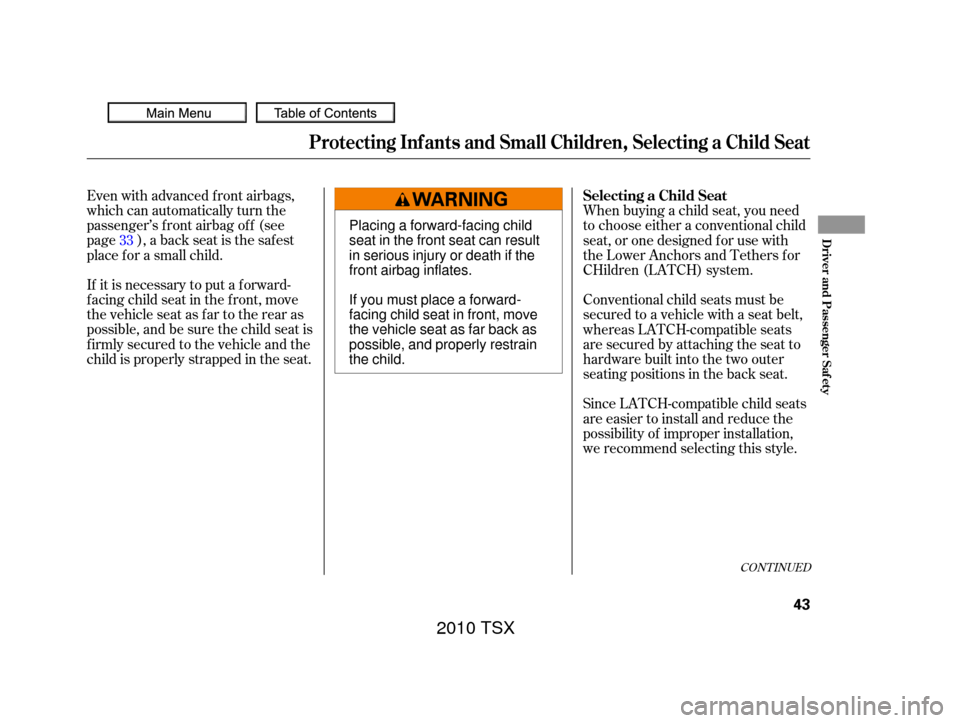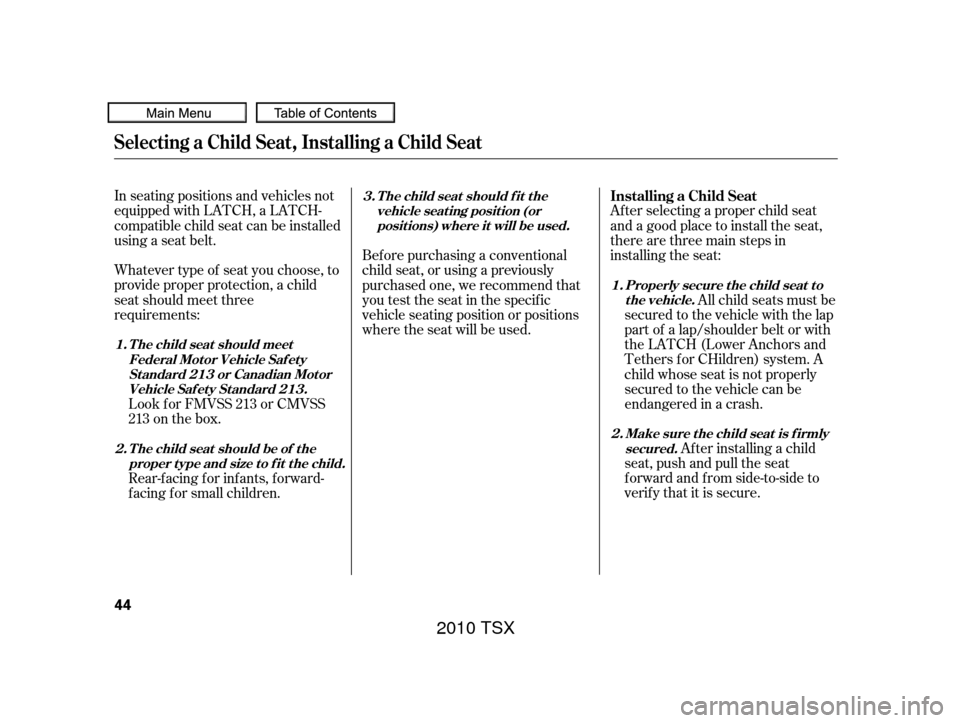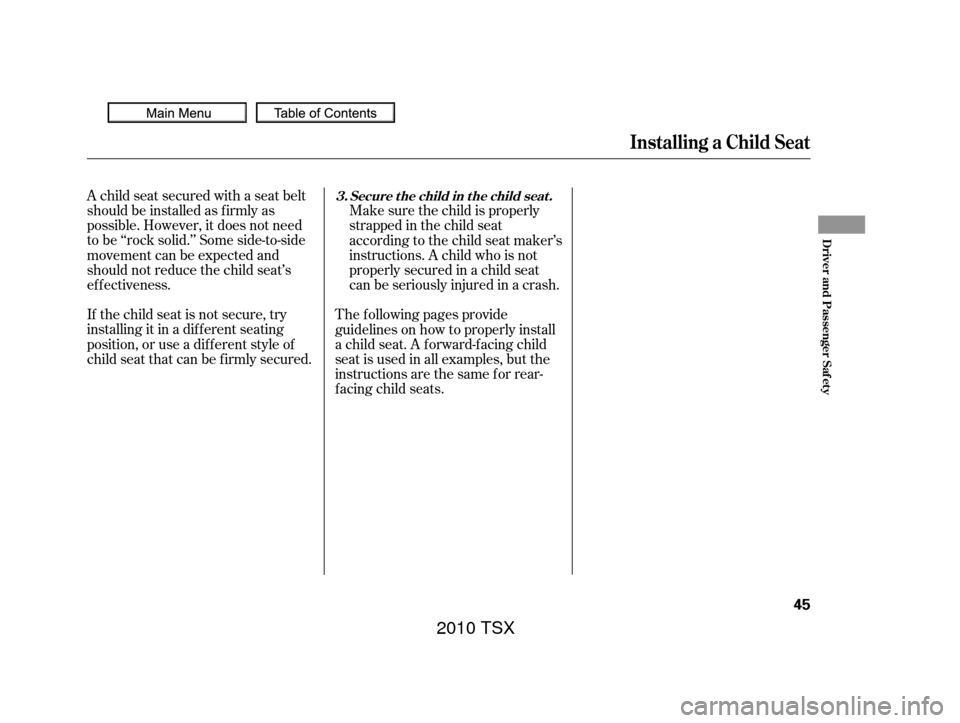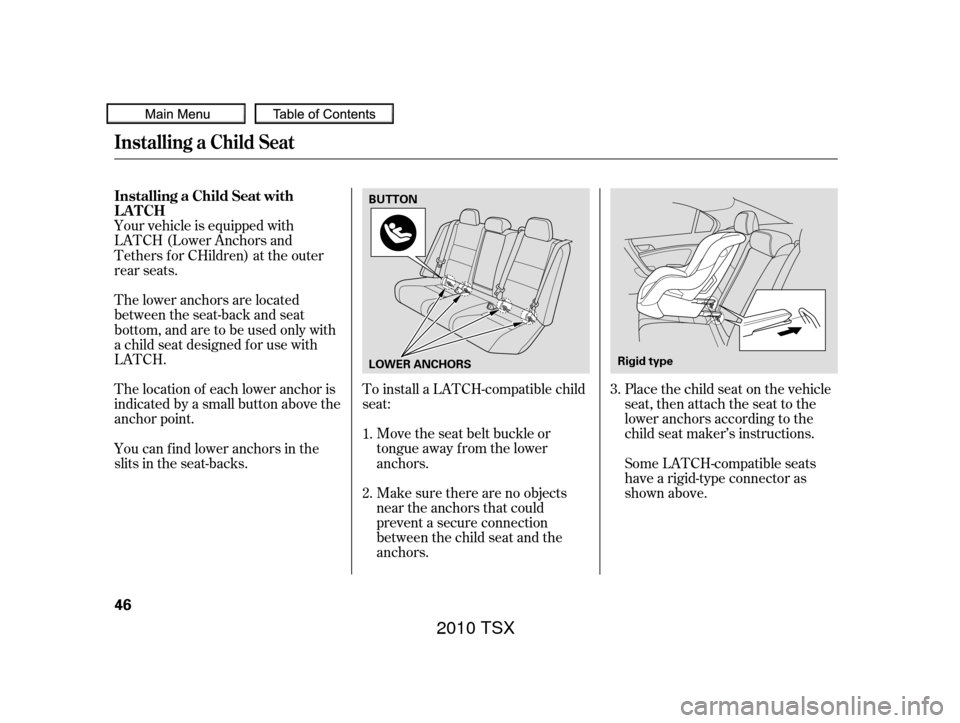child seat Acura TSX 2010 Owner's Guide
[x] Cancel search | Manufacturer: ACURA, Model Year: 2010, Model line: TSX, Model: Acura TSX 2010Pages: 524, PDF Size: 12.34 MB
Page 45 of 524

In any of these situations, we
strongly recommend that you install
the child seat directly behind the
f ront passenger’s seat, move the seat
as far forward as needed, and leave it
unoccupied. Or, you may wish to get
a smaller rear-f acing child seat.Many states, Canadian provinces and
territories allow a child one year of
age or older who also meets the
minimum size and weight
requirements to transition f rom a
rear-facing child seat to a forward
f acing seat. Know the requirements
where you are driving and follow the
child seat instructions. Many experts
recommend use of a rear-f acing seat
up to age two, if the child’s heightand weight are appropriate f or a
rear-facing seat.
If the vehicle seat is too
farforward,orthechild’sheadis
thrown f orward during a collision, an
inf lating airbag can strike the child
with enough force to cause very
serious or fatal injuries. We strongly recommend placing a
forward-facing child seat in a back
seat, not the f ront. We also recommend that a small
child use the child seat until the child
reaches the weight or height limit
for the seat. Of the different seats available, we
recommend those that have a f ive-
point harness system as shown.
Protecting Small Children
Child Seat T ype
Placing a f orward-f acing child seat inthe f ront seat of a vehicle equippedwith a passenger’s airbag can behazardous.
Child Seat Placement
Protecting Inf ants and Small Children
42
Placing a rear-facing child seat
in the front seat can result in
serious injury or death during a
collision.
Always place a rear-facing child
seat in the back seat, not the
front.
2010 TSX
Page 46 of 524

Even with advanced front airbags,
which can automatically turn the
passenger’s front airbag off (see
page ), a back seat is the saf est
place f or a small child.
If it is necessary to put a f orward-
f acing child seat in the f ront, move
the vehicle seat as far to the rear as
possible, and be sure the child seat is
f irmly secured to the vehicle and the
child is properly strapped in the seat.When buying a child seat, you need
to choose either a conventional child
seat, or one designed f or use with
the Lower Anchors and Tethers f or
CHildren (LATCH) system.
Conventional child seats must be
secured to a vehicle with a seat belt,
whereas LATCH-compatible seats
are secured by attaching the seat to
hardware built into the two outer
seating positions in the back seat.
Since LATCH-compatible child seats
are easier to install and reduce the
possibility of improper installation,
we recommend selecting this style.
33
CONT INUED
Protecting Inf ants and Small Children, Selecting a Child Seat
Selecting a Child Seat
Driver and Passenger Saf ety
43
Placing a forward-facing child
seat in the front seat can result
in serious injury or death if the
front airbag inflates.
Ifyoumustplaceaforward-
facing child seat in front, move
the vehicle seat as far back as
possible, and properly restrain
the child.
2010 TSX
Page 47 of 524

In seating positions and vehicles not
equipped with LATCH, a LATCH-
compatible child seat can be installed
using a seat belt.Af ter selecting a proper child seat
and a good place to install the seat,
there are three main steps in
installing the seat:
Af ter installing a child
seat, push and pull the seat
f orward and f rom side-to-side to
verify that it is secure.
Whatever type of seat you choose, to
provide proper protection, a child
seat should meet three
requirements:
Look f or FMVSS 213 or CMVSS
213 on the box. Bef ore purchasing a conventional
child seat, or using a previously
purchased one, we recommend that
you test the seat in the specif ic
vehicle seating position or positions
where the seat will be used.
Rear-facing for infants, forward-
f acing f or small children. All child seats must be
secured to the vehicle with the lap
part of a lap/shoulder belt or with
the LATCH (Lower Anchors and
Tethers f or CHildren) system. A
child whose seat is not properly
secured to the vehicle can be
endangered in a crash.
Installing a Child Seat
Make sure t he child seat is f irmly
secured.
T he child seat should meet
Federal Mot or Vehicle Saf et ySt andard 213 or Canadian Mot orVehicle Saf et y St andard 213. T he child seat should f it the
vehicle seat ing posit ion (orposit ions) where it will be used.
T he child seat should be of the proper type and size to f it the child. Properly secure t he child seat t o
the vehicle.
1.
2. 3.
1.
2.
Selecting a Child Seat, Installing a Child Seat
44
2010 TSX
Page 48 of 524

A child seat secured with a seat belt
should be installed as f irmly as
possible. However, it does not need
to be ‘‘rock solid.’’ Some side-to-side
movement can be expected and
should not reduce the child seat’s
ef f ectiveness.
If the child seat is not secure, try
installing it in a dif f erent seating
position, or use a dif f erent style of
child seat that can be f irmly secured.Make sure the child is properly
strappedinthechildseat
according to the child seat maker’s
instructions. A child who is not
properly secured in a child seat
can be seriously injured in a crash.
The f ollowing pages provide
guidelines on how to properly install
a child seat. A f orward-f acing child
seat is used in all examples, but the
instructions are the same f or rear-
f acing child seats.
Installing a Child Seat
Secure the child in the child seat.
3.
Driver and Passenger Saf ety
45
2010 TSX
Page 49 of 524

Make sure there are no objects
near the anchors that could
prevent a secure connection
between the child seat and the
anchors. Move the seat belt buckle or
tongue away f rom the lower
anchors.
To install a LATCH-compatible child
seat:
Place the child seat on the vehicle
seat, then attach the seat to the
lower anchors according to the
child seat maker’s instructions.
Your vehicle is equipped with
LATCH (Lower Anchors and
Tethers for CHildren) at the outer
rear seats.
Some LATCH-compatible seats
have a rigid-type connector as
shown above.
You can f ind lower anchors in the
slits in the seat-backs. The location of each lower anchor is
indicated by a small button above the
anchor point. The lower anchors are located
between the seat-back and seat
bottom, and are to be used only with
a child seat designed f or use with
LATCH.
1.
2.3.
Installing a Child Seat with
LATCH
Installing a Child Seat
46
LOWER ANCHORS
Rigid type
BUTTON
2010 TSX
Page 50 of 524

Whatever type you have, f ollow
the child seat maker’s instructions
f or adjusting or tightening the f it. Other LATCH-compatible seats
have a f lexible-type connector as
shown above.Pushandpullthechildseat
f orward and f rom side-to-side to
verify that it is secure. Attach the tether strap hook to the
tether anchor, then tighten the
strap as instructed by the child
seat maker.
Route the tether strap through the
legs of the head restraint and over
the seat-back, making sure the
strap is not twisted.
Set the head restraint to its
highest position.
4.
5. 6.7.
8.
Installing a Child Seat
Driver and Passenger Saf ety
47
TETHER STRAP HOOK
Flexible type ANCHOR
2010 TSX
Page 51 of 524

When not using the LATCH system,
all child seats must be secured to the
vehicle with the lap part of a lap/
shoulder belt.To activate the lockable retractor,
slowly pull the shoulder part of the
belt all the way out until it stops,
then let the belt feed back into the
retractor.
Af ter the belt has retracted, tug on
it. If the belt is locked, you will not
be able to pull it out. If you can pull
thebeltout,itisnotlocked,and
you will need to repeat these steps.
In addition, the lap/shoulder belts in
all seating positions except the
driver’s have a lockable retractor
that must be activated to secure a
child seat.
With the child seat in the desired
seating position, route the belt
through the child seat according
to the seat maker’s instructions,
then insert the latch plate into the
buckle and remove any slack f rom
the lap portion of the belt.
1.
2.
3.
Installing a Child Seat with a L ap/
Shoulder Belt
Installing a Child Seat
48
2010 TSX
Page 52 of 524

Af ter conf irming that the belt is
locked, grab the shoulder part of
the belt near the buckle, and pull
up to remove any slack from the
lap part of the belt. Remember, if
the lap part of the belt is not tight,
the child seat will not be secure.Push and pull the child seat
f orward and f rom side-to-side to
verify that it is secure enough to
stay upright during normal driving
maneuvers. If the child seat is not
secure, unlatch the belt, allow it to
retract f ully, then repeat these
steps.
To remove slack, it may help to
putweightonthechildseat,or
push on the back of the seat while
pulling up on the belt. To deactivate the lockable retractor
andremoveachildseat,unlatchthe
buckle, unroute the seat belt, and let
the belt fully retract.
4. 5.
Installing a Child Seat
Driver and Passenger Saf ety
49
2010 TSX
Page 53 of 524

Lift the anchor cover, then attach
the tether strap hook to the
anchor, making sure the strap is
not twisted.
Tighten the strap according to the
seat maker’s instructions.
A child seat with a tether can be
installed in any seating position in
the back seat, using one of the
anchorage points shown above.
Since a tether can provide additional
security to the lap/shoulder belt
installation, we recommend using a
tether whenever one is required or
available. Af ter properly securing the child
seat (see page ), route the
tether strap over the seat-back and
through the head restraint legs. Set the head restraint to its
highest position.
1.
2. 3.
4.
48
Installing a Child Seat
Installing a Child Seat with a
TetherUsing an A nchor
50
TETHER STRAP HOOK
ANCHOR
ANCHOR
ANCHOR COVER
TETHER ANCHORAGE POINTS
Center Position
Outer Position TETHER STRAP HOOK
2010 TSX
Page 54 of 524

To determine if a lap/shoulder belt
properly f its a child, have the child
put on the seat belt, then ask
yourself :Does the child sit all the way back
against the seat?
Do the child’s knees bend
comf ortably over the edge of the
seat?
When a child reaches the
recommended weight or height limit
for a forward-facing child seat, the
child should sit in a back seat on a
booster seat and wear the lap/
shoulder belt.
The f ollowing pages give
instructions on how to check proper
seat belt f it, what kind of booster
seat to use if one is needed, and
important precautions f or a child
who must sit in f ront.
1.
2.
CONT INUED
Protecting L arger Children
Checking Seat Belt Fit
Driver and Passenger Saf ety
51
Allowing a child age 12 or under
to sit in front can result in injury
or death if the passenger’s front
airbag inflates.
If a child must ride in front,
move the vehicle seat as far
back as possible, use a booster
seat if needed, have the child
sit up properly and wear the
seat belt properly.
2010 TSX